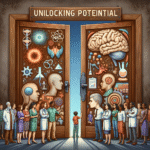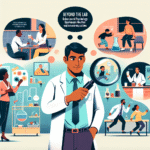Introduction
Love—an emotion that has inspired countless poems, songs, and stories—remains one of the most profound experiences in human life. But what happens in our brains when we fall in love? In this article, The Brain in Love: Understanding the Neurobiology Behind Romantic Connections, we will explore the intricate mechanisms of the brain that underpin romantic connections. By delving into the neurobiology of love, we can gain insights into how our brains respond to affection, attachment, and intimacy, empowering us to better understand our emotions and relationships.
The Chemistry of Love
The Love Hormones: Oxytocin and Vasopressin
At the heart of romantic connections are two key hormones: oxytocin and vasopressin. Often dubbed the "love hormones," these neuropeptides play a critical role in bonding, trust, and intimacy.
-
Oxytocin: Released during moments of physical touch, such as hugging or cuddling, oxytocin is a powerful facilitator of emotional connections. It enhances feelings of safety and trust, influencing us to forge stronger bonds with our partners.
- Vasopressin: While primarily associated with regulating water balance in the body, vasopressin also plays a crucial role in social behaviors. Studies have shown that higher levels of vasopressin are linked to increased sexual desire and pair-bonding in certain species and humans alike.
Table 1: The Role of Oxytocin and Vasopressin in Romantic Relationships
| Hormone | Function | Effects on Relationships |
|---|---|---|
| Oxytocin | Enhances trust and bonding | Promotes attachment and emotional intimacy |
| Vasopressin | Regulates social behaviors | Influences sexual desire and commitment |
Dopamine: The Pleasure Chemical
Beyond hormones, the neurotransmitter dopamine is also integral to the brain’s perception of love. Often dubbed the "pleasure chemical," dopamine is released during pleasurable situations, including moments spent with loved ones.
When we experience attraction, dopamine floods the brain, reinforcing feelings of pleasure and reward. This cascade of neurotransmitters can create a sense of euphoria akin to a drug high, making love not only a beautiful experience but also an addictive one.
The Brain’s Love Circuitry
Brain Regions Involved in Love
When examining The Brain in Love: Understanding the Neurobiology Behind Romantic Connections, several brain regions are critical:
-
Ventral Tegmental Area (VTA): This area is rich in dopamine-producing neurons and is highly active when we feel romantic love. The VTA’s activation is associated with the feelings of motivation and reward, propelling individuals toward their partners.
-
Caudate Nucleus: Related to the brain’s reward system, the caudate nucleus activates when we think about or are near our loved ones, bolstering our attachments and desires.
- Prefrontal Cortex: This area controls decision-making and self-regulation. In love, the prefrontal cortex may become less active, which can lead to impulsive behaviors and decisions in the name of romance.
Chart 1: Brain Regions Activated During Romantic Love
Note: This placeholder indicates where a chart would be located in the finalized article.
Case Study: The Neurobiology of Long-Distance Relationships
One fascinating case study involves the neurobiology of long-distance relationships. Research shows that partners in long-distance setups often report feelings of deeper emotional connection, despite the physical separation.
One study published in the Journal of Social and Personal Relationships found that when individuals in long-distance relationships were reunited, their brains exhibited heightened activity in the same regions associated with romantic attraction. This suggests that while distance can be challenging, love can foster even stronger bonds through anticipation and longing.
Analysis: This case study illustrates how the brain’s response to love can enhance the emotional experience, even when partners are apart. Such insights can further aid understanding of romantic dynamics.
The Stages of Love: A Neurobiological Perspective
Understanding the brain’s involvement in love also requires examining the distinct stages of romantic relationships, often categorized into three main phases: lust, attraction, and attachment.
Lust: The Initial Spark
The lust phase is primarily fueled by sex hormones, including testosterone and estrogen. These hormones drive sexual attraction and desire, stimulating the initial spark of romantic interest.
Attraction: The Emotional Connection
During the attraction phase, the brain’s reward circuitry intensifies, characterized by increased dopamine and norepinephrine levels. This leads to euphoric feelings when thinking about or being with a partner, often inducing obsessive thinking and a preoccupation with the loved one.
Attachment: The Lasting Bond
In the attachment phase, both oxytocin and vasopressin play significant roles in helping couples bond and maintain long-term relationships. This phase is characterized by a growing comfort with one’s partner and a sense of stability in the relationship.
Love in the Age of Technology
Online Dating and Its Effects on Romantic Connections
The rise of online dating platforms has transformed the way we connect and form relationships. A study published in Computers in Human Behavior suggests that electronic communication can foster intimacy, yet it often lacks the emotional depth of face-to-face interactions.
In a world where swiping is the norm, understanding The Brain in Love: Understanding the Neurobiology Behind Romantic Connections is crucial. The fast-paced nature of online dating may lead to quicker emotional attachments, but it can also cause individuals to overlook deeper compatibility factors.
Case Study: A survey of online daters revealed that while many individuals report feeling an initial attraction, the effective connection often relies on in-person interactions for deeper bonding.
Analysis: This indicates that the brain’s mechanisms for love remain consistent even as the methods of connection evolve, emphasizing the importance of physical presence in fostering true intimacy.
Love and Mental Health
The Positive Effects of Romance on Mental Well-Being
Engaging in romantic relationships can have a profound impact on mental health. Studies indicate that couples in healthy relationships experience lower levels of stress and anxiety. Emotional support derived from a partner can enhance resilience during life’s challenges.
Conversely, the brain’s response to love can also mirror that of physical pain—leading to the term "heartbreak." Understanding how love and emotional connections affect mental health is essential for promoting healthy relationships.
Table 2: Positive Effects of Romantic Relationships on Mental Health
| Positive Effects | Explanation |
|---|---|
| Reduced Stress Levels | Emotional support decreases cortisol levels |
| Enhanced Happiness | Increased serotonin and endorphins from positive interactions |
| Improved Coping Mechanisms | Shared experience fosters resilience and strength |
Conclusion
In summary, The Brain in Love: Understanding the Neurobiology Behind Romantic Connections reveals a complex interplay of hormones, neurotransmitters, and brain regions that govern our experiences of love. The surge of dopamine during attraction, the soothing presence of oxytocin in attachment, and the powerful signals from our brain’s reward system all contribute to the phenomenon we cherish as romantic love.
Understanding these neurobiological processes not only enhances our insight into our own emotions but also empowers us to nurture healthier relationships. As we navigate the landscape of modern romance, let’s embrace the intricacies of our brains and the magic of love, fostering connections that enrich our lives.
FAQs
1. How does love affect brain chemistry?
Love activates neurotransmitters like dopamine and hormones such as oxytocin, creating feelings of pleasure, attachment, and reward.
2. Can love decrease stress levels?
Yes, being in a loving relationship can lower stress hormones and enhance feelings of security and emotional support.
3. What role does the VTA play in romantic love?
The ventral tegmental area (VTA) is crucial in the reward system. It releases dopamine, reinforcing pleasurable feelings associated with romantic attraction.
4. Are long-distance relationships different from regular relationships neurologically?
Research indicates that while they may involve unique challenges, brain responses during reunions can show even greater activation in the love regions compared to standard relationships.
5. How can understanding the neurobiology of love improve relationships?
By understanding how our brains respond to love and affection, we can make informed choices about fostering emotional connections, addressing conflicts, and enhancing our intimate bonds.
Through this exploration of neurobiology, may you better navigate the intricate labyrinth of love, armed with knowledge that elevates both your experiences and your relationships.

















